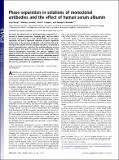Phase separation in solutions of monoclonal antibodies and the effect of human serum albumin
Author(s)
Wang, Ying; Lomakin, Aleksey; Latypov, Ramil F.; Benedek, George B.
DownloadWang-2011-Phase separation in.pdf (280.9Kb)
PUBLISHER_POLICY
Publisher Policy
Article is made available in accordance with the publisher's policy and may be subject to US copyright law. Please refer to the publisher's site for terms of use.
Terms of use
Metadata
Show full item recordAbstract
We report the observation of liquid-liquid phase separation in a solution of human monoclonal antibody, IgG2, and the effects of human serum albumin, a major blood protein, on this phase separation. We find a significant reduction of phase separation temperature in the presence of albumin, and a preferential partitioning of the albumin into the antibody-rich phase. We provide a general thermodynamic analysis of the antibody-albumin mixture phase diagram and relate its features to the magnitude of the effective interprotein interactions. Our analysis suggests that additives (HSA in this report), which have moderate attraction with antibody molecules, may be used to forestall undesirable proetin condensation in antibody solutions. Our findings are relevant to understanding the stability of pharmaceutical solutions of antibodies and the mechanisms of cryoglobulinemia.
Date issued
2011-10Department
MIT Materials Research Laboratory; Massachusetts Institute of Technology. Department of PhysicsJournal
Proceedings of the National Academy of Sciences
Publisher
National Academy of Sciences
Citation
Wang, Y. et al. “Phase Separation in Solutions of Monoclonal Antibodies and the Effect of Human Serum Albumin.” Proceedings of the National Academy of Sciences 108.40 (2011): 16606–16611. Copyright ©2011 by the National Academy of Sciences
Version: Final published version
ISSN
0027-8424
1091-6490